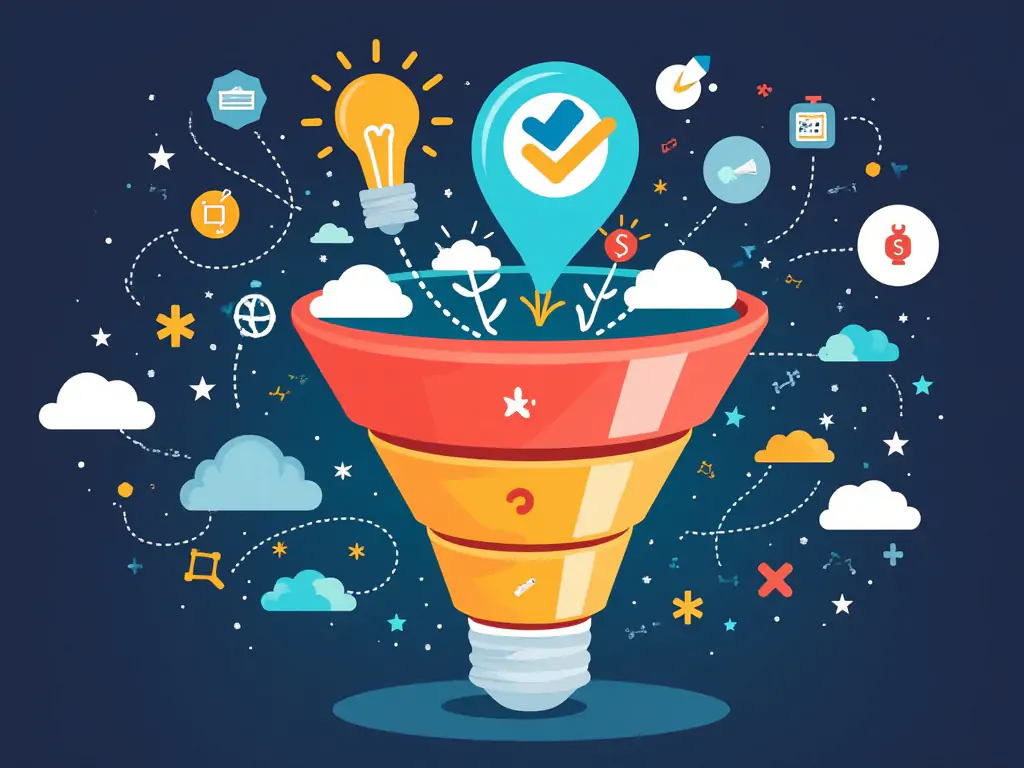Is your startup’s sales funnel underperforming? Many entrepreneurs face this challenge, struggling to convert leads into customers effectively. A broken sales funnel can severely impact your business growth and revenue.
By identifying and addressing key issues in your funnel, you can potentially double your conversion rates. Common problems include poor lead capture mechanisms and ineffective engagement strategies. These issues often stem from targeting the wrong audience or using overly complex conversion paths.
Fixing a broken sales funnel requires a data-driven approach. Analyzing metrics at each stage of the funnel can reveal bottlenecks and areas for improvement. By optimizing your marketing strategy based on these insights, you can streamline the customer journey and boost conversions significantly.
Key Takeaways
- Identify and address bottlenecks in your sales funnel to improve conversion rates
- Use data-driven insights to optimize your marketing strategy and customer journey
- Regularly analyze and adjust your funnel to ensure it aligns with your target audience’s needs
Identifying the Flaws in Your Sales Funnel

Pinpointing issues in your startup’s sales funnel is crucial for optimizing conversions. A thorough analysis of each stage can reveal bottlenecks and inefficiencies that hinder your sales process.
Understanding Sales Funnel Stages
Sales funnels typically consist of four main stages: awareness, interest, decision, and action. Each stage requires specific strategies to move leads forward.
The awareness stage focuses on attracting potential customers. Here, effective messaging is key to capture attention and introduce your product or service.
In the interest stage, leads begin to engage with your content. Providing valuable information helps nurture these prospects and build trust.
The decision stage is where qualified leads evaluate options. Offering compelling reasons to choose your solution is critical at this point.
Finally, the action stage is where conversions happen. A smooth, frictionless process is essential to close deals and turn leads into customers.
Common Bottlenecks and Their Impact
Identifying bottlenecks in your sales funnel is essential for improving conversion rates. These issues can occur at any stage and significantly impact your results.
A common bottleneck is poor data tracking. Without proper analytics, it’s challenging to understand where leads are dropping off and why.
Ineffective lead qualification can also create a bottleneck. If unqualified leads progress too far, they waste resources and reduce overall conversion rates.
Slow response times often lead to lost opportunities. Implementing automated follow-ups can help maintain momentum and keep leads engaged.
Misaligned messaging across funnel stages can confuse potential customers. Ensuring consistency in your communication helps guide leads smoothly through the process.
Lastly, a complicated checkout process can deter customers at the final stage. Simplifying this step can significantly boost conversions and reduce cart abandonment.
Optimizing the Top of the Funnel for Better Lead Generation

Effective lead generation starts with attracting and engaging potential customers at the top of the sales funnel. By focusing on content marketing, SEO, and compelling lead magnets, startups can significantly increase their pool of qualified prospects.
Leveraging Content Marketing and SEO
Content marketing and SEO work hand-in-hand to boost awareness and attract potential customers. High-quality, relevant content helps establish authority and trust with the target audience. Blog posts, videos, and infographics addressing common pain points can drive organic traffic.
Optimizing content for search engines increases visibility. This involves:
- Keyword research to identify relevant search terms
- On-page SEO techniques like meta descriptions and header tags
- Building backlinks from reputable sources
Social media platforms amplify content reach. Sharing valuable insights and engaging with followers builds brand recognition and drives traffic to the company website.
Creating Effective Lead Magnets
Lead magnets are valuable resources offered in exchange for contact information. These tools help capture leads and move them further down the funnel. Effective lead magnets include:
- Ebooks or whitepapers addressing industry challenges
- Free tools or calculators that solve specific problems
- Exclusive webinars or video training sessions
The key is to align lead magnets with the target audience’s needs and interests. This ensures higher conversion rates and better-qualified leads entering the funnel.
To maximize impact, promote lead magnets through:
- Prominent website placement
- Targeted email campaigns
- Social media advertising
By offering genuine value, startups can build trust and credibility while expanding their lead database.
Enhancing Mid-Funnel Engagement and Conversions

Mid-funnel marketing is crucial for moving potential customers closer to a purchase decision. Effective tactics focus on delivering value, building trust, and addressing specific pain points to increase conversions.
Improving Landing Pages and Calls to Action
Landing pages serve as critical touchpoints for mid-funnel prospects. They should be tailored to specific demographics and buyer personas. Clear, compelling headlines that address pain points grab attention immediately.
Concise copy highlighting key benefits and social proof builds credibility. Use bullet points to make information easily scannable. High-quality images or videos can illustrate product features effectively.
Strong calls to action (CTAs) are essential. Use action-oriented language and create a sense of urgency. A/B testing different CTA colors, placements, and wording can significantly improve conversion rates.
Utilizing Email Marketing and Lead Nurturing
Email marketing remains a powerful tool for mid-funnel engagement. Segment the email list based on prospect behavior and interests to deliver personalized content.
Drip campaigns can nurture leads over time. Each email should provide value, whether through educational content, case studies, or exclusive offers. Include clear CTAs in every message.
Automated workflows triggered by specific actions can deliver timely, relevant information. For example, send a follow-up email with additional resources after a prospect downloads a whitepaper.
Presenting Demos and Free Trials Effectively
Product demos and free trials are excellent for showcasing value and overcoming objections. Interactive product demos allow prospects to experience the solution firsthand.
Limit free trial periods to create urgency. Provide clear instructions and support to ensure prospects can quickly see the product’s benefits. Follow up with targeted emails highlighting key features.
For SaaS products, consider offering a “freemium” model. This allows users to access basic features indefinitely, encouraging long-term engagement and potential upgrades.
Converting Leads into Paying Customers

The transition from lead to customer is critical for startup success. Effective strategies can significantly boost conversion rates and increase average order value through targeted upselling and cross-selling techniques.
Creating a Seamless Transition to Sales
A smooth handoff from marketing to sales is crucial for converting leads into paying customers. Sales teams should have access to detailed lead information to personalize their approach. Implementing a lead scoring system helps prioritize high-potential prospects.
Clear communication channels between marketing and sales teams ensure a cohesive message throughout the customer journey. Automated email sequences can nurture leads, providing valuable information and addressing common objections before sales contact.
Timely follow-ups are essential. Studies show that contacting a lead within 5 minutes of their inquiry increases conversion chances by 900%. Sales representatives should be prepared with tailored pitches and solutions based on the lead’s specific needs and pain points.
Incorporating Upselling and Cross-Selling Strategies
Upselling and cross-selling can significantly increase the average order value and customer lifetime value. Sales teams should identify complementary products or premium options that align with the customer’s needs.
Training sales representatives to recognize upsell opportunities is crucial. They should be able to articulate the added value of higher-tier products or services. Timing is key – introducing upsell options too early may deter potential customers.
Cross-selling works best when products genuinely enhance the customer’s experience. Bundle offers or package deals can incentivize additional purchases. Sales teams should use data analytics to identify patterns in customer behavior and preferences, enabling more targeted cross-selling recommendations.
Post-purchase follow-ups present additional opportunities for upselling and cross-selling, turning one-time buyers into repeat customers.
Measuring Success and Making Data-Driven Decisions

Effective measurement and data-driven decision making are crucial for optimizing your startup’s sales funnel. By focusing on key metrics and utilizing A/B testing, you can identify areas for improvement and implement changes that significantly boost conversions.
Key Metrics to Monitor
Data-driven sales strategies rely on tracking critical metrics. Conversion rate measures the percentage of leads that become customers. Click-through rates indicate the effectiveness of email campaigns and ads. Customer acquisition cost (CAC) reveals the expense of gaining new customers.
Revenue per customer and customer lifetime value (CLV) show the long-term profitability of acquired customers. Churn rate tracks customer retention. Sales cycle length helps optimize the funnel’s efficiency.
Customer feedback and reviews provide qualitative insights into satisfaction and areas for improvement. Net Promoter Score (NPS) quantifies customer loyalty and likelihood to recommend.
Iterative Sales Funnel Improvement Through A/B Testing
A/B testing is a powerful tool for making data-driven decisions to enhance sales funnel performance. This method involves creating two versions of a funnel element and comparing their performance.
Test different landing page designs, call-to-action buttons, or email subject lines. Analyze how changes impact conversion rates and customer behavior. Start with small, incremental changes and measure their effects.
Continuously iterate based on test results. Implement successful changes across the funnel. Regular testing helps adapt to evolving customer preferences and market conditions.
Frequently Asked Questions

Sales funnels are complex systems that require careful planning and execution. Understanding common issues and effective strategies is crucial for optimizing performance and driving conversions.
What are common pitfalls in developing an effective sales funnel?
Many startups struggle with targeting the wrong audience for their products or services. This misalignment can lead to wasted resources and poor conversion rates.
Another frequent issue is creating an overly complex conversion path. A convoluted process can frustrate potential customers and cause them to abandon the funnel prematurely.
How can you identify weaknesses within a sales funnel that affect conversion rates?
Analyzing data from various sources is essential for pinpointing funnel weaknesses. Google Analytics, email service providers, and CRM systems can provide valuable insights into user behavior and drop-off points.
Tracking key metrics such as click-through rates, time spent on pages, and conversion rates at each stage helps identify areas for improvement.
What strategies can be implemented to improve sales funnel performance?
Simplifying the conversion path is an effective strategy. Removing unnecessary steps and streamlining the process can reduce friction and increase conversions.
Improving customer support and interaction throughout the funnel can also boost performance. Providing timely assistance and addressing concerns can prevent potential customers from losing interest.
In what ways does a sales funnel contribute to increased sales conversions?
A well-designed sales funnel guides potential customers through a logical sequence of steps, nurturing their interest and addressing concerns along the way.
By providing relevant information and targeted messaging at each stage, a funnel helps build trust and credibility, increasing the likelihood of conversion.
How critical is lead nurturing in preventing sales funnel drop-offs?
Lead nurturing plays a vital role in maintaining engagement and preventing drop-offs. Regular communication and personalized content keep leads interested and moving through the funnel.
Email marketing campaigns are particularly effective for lead nurturing, providing valuable information and encouraging continued interaction with the brand.
What role does marketing play in optimizing a sales funnel for better results?
Marketing is crucial in attracting the right audience to enter the funnel. Targeted campaigns and content help ensure that qualified leads are entering the sales process.
Effective marketing also supports each stage of the funnel by creating compelling messaging and offers that resonate with potential customers and drive them towards conversion.


